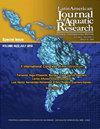Prochlorococcus and Synechococcus marine cyanobacteria: a scientometrics review
IF 0.8
4区 农林科学
Q3 FISHERIES
Latin American Journal of Aquatic Research
Pub Date : 2023-08-31
DOI:10.3856/vol51-issue4-fulltext-2949
引用次数: 0
Abstract
Prochlorococcus and Synechococcus are the dominant primary producers in the ocean and account for a significant percentage of oceanic carbon fixation. This review summarizes the available data in the literature (1992-2021; n = 480) using CiteSpace software to provide insights into the specific characteristics of Prochlorococcus and Synechococcus genes that scientists can use for establishing future research directions. From 1992 to 2021, the most frequent and with higher centrality keyword was "multiple evolutionary origin" (0.43), followed by flow cytometry (0.40), because this period was the main method used to identify cyanobacteria. In 2001-2010, were "sequence" and "gene", both with 0.13 of centrality; this can be explained by the period when gene sequencing was developed. In the last 10 years period 2011-2021, were diversity (0.17); marine Synechococcus (0.10); Prochlorococcus ecotype (0.08); gene expression (0.14). Additionally, the migration characteristics of flow cytometry, genes identification methods, genomes, and ecotypes of cyanobacteria, indicate how future studies should focus in 1) molecular ecology: how genetic variability among different populations affects their adaptation to different ocean environments, 2) physiology: how this phytoplankton respond to changes in nutrient availability and solar radiation, 3) interactions with other living beings: how they interact with other organisms, such as bacteria, zooplankton, and fish, and how these interactions affect the dynamics of the ocean ecosystem, and 4) modeling: computational models are being developed to predict how the distribution will change in the future as a result of climate change and human use of the oceans.原绿球藻和聚球藻海洋蓝藻:科学计量学综述
原绿球藻和聚球藻是海洋中主要的初级生产者,在海洋固碳中占很大比例。这篇综述总结了文献(1992-2021;n=480)中的可用数据,使用CiteSpace软件来深入了解原绿球藻和聚球藻基因的特定特征,科学家可以用来确定未来的研究方向。从1992年到2021年,最常见且中心性较高的关键词是“多重进化起源”(0.43),其次是流式细胞术(0.40),因为这一时期是鉴定蓝藻的主要方法。2001-2010年为“序列”和“基因”,两者的中心性均为0.13;这可以用基因测序发展的时期来解释。在2011-2021年的过去10年中,多样性(0.17);海洋聚球藻(0.10);原绿球藻生态型(0.08);基因表达(0.14)。此外,流式细胞术的迁移特征、基因鉴定方法、基因组和蓝藻的生态型表明,未来的研究应该集中在1)分子生态学:不同种群之间的遗传变异如何影响它们对不同海洋环境的适应,2)生理学:浮游植物如何对营养物质可用性和太阳辐射的变化做出反应,3)与其他生物的相互作用:它们如何与其他生物相互作用,如细菌、浮游动物和鱼类,以及这些相互作用如何影响海洋生态系统的动态,以及4)建模:正在开发计算模型,以预测未来由于气候变化和人类对海洋的利用,分布将如何变化。
本文章由计算机程序翻译,如有差异,请以英文原文为准。
求助全文
约1分钟内获得全文
求助全文
来源期刊

Latin American Journal of Aquatic Research
FISHERIES-MARINE & FRESHWATER BIOLOGY
CiteScore
1.70
自引率
10.00%
发文量
44
审稿时长
4-8 weeks
期刊介绍:
Latin American Journal of Aquatic Research- LAJAR is the continuation of the journal Investigaciones Marinas (1970-2007) and is published since 2008 by the Escuela de Ciencias del Mar, Facultad de Ciencias del Mar y Geografía of the Pontificia Universidad Católica de Valparaíso. LAJAR is an “Open Access” journal that publishes in English language, original research articles, reviews and short communications on aquatic science, which contain the results of research conducted in aquaculture or in oceanic and coastal marine waters of Latin America.
The following topics are considered: Physical Oceanography, Chemical Oceanography, Marine Biogeochemistry, Marine Pollution and Toxicology, Marine Geology and Geophysics, Biological Oceanography, Fisheries and Aquaculture.
 求助内容:
求助内容: 应助结果提醒方式:
应助结果提醒方式:


